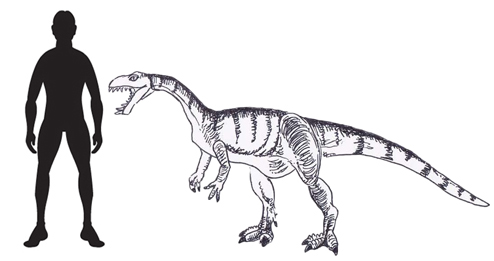Getting Ready for the Wild Safari Prehistoric World Masiakasaurus
Arriving later this month will be the new Wild Safari Prehistoric World models. Amongst these eagerly awaited replicas will be a model of the fearsome Masiakasaurus (M. knopfleri). Classified as a member of the abelisaurid group of theropod dinosaurs, this lithe hunter roamed the semi-arid plains of Madagascar. A number of fossil specimens are known and the species name comes from the rock musician Mark Knopfler, whose music was being played by field team members as they toiled in the sun to extract the first of this dinosaur’s fossil bones. This dinosaur was named in 2001.
A Scale Illustration of the Bizarre Masiakasaurus
Picture credit: Everything Dinosaur
Masiakasaurus
Measuring no more than two metres in length and weighing about forty kilogrammes, this dinosaur had to avoid the much bigger Majungasaurus (also known as Majungatholus). The diet of this dinosaur remains open to speculation. Some palaeontologists have argued that the lower jaw with its strange arrangement of teeth that point forwards and are hooked upwards indicates that this dinosaur may have specialised in catching fish. Although, a generalist feeder and scavenger have also been proposed with regards to this theropod’s eating habits.
To view the Wild Safari Prehistoric World model range: Safari Ltd. Dinosaur Models.
Madagascar – The World’s Oldest Island
By the end of the Cretaceous (Maastrichtian faunal stage), Madagascar had fully detached from the remnants of the super-continent Gondwana. It was an island just like Madagascar today, but it was much hotter and prone to extreme droughts.
Scientists who have studied the ancient palaeoclimate suggest that there were occasional devastating floods, but for much of the time there was little rainfall. The inhabitants of the island, including a diverse dinosaur fauna, faced long periods of drought. This would have put the animal population under extreme pressure and evidence of cannibalism has been uncovered amongst the apex predators.
It has been suggested that the skull of a Majungatholus that showed bite marks indicated that Masiakasaurus had fed on the remains of one of these fallen giants. However, the scratch marks in the fossil bone do not match the dentition of Masiakasaurus. It is now thought that another Majungatholus attacked, killed and ate the Majungatholus, the first evidence of cannibalism documented in the Dinosauria of the Late Cretaceous.
CollectA have a number of abelisaurid dinosaurs in their “Prehistoric World” range of models.
To view this range: CollectA Prehistoric World Models.







Leave A Comment